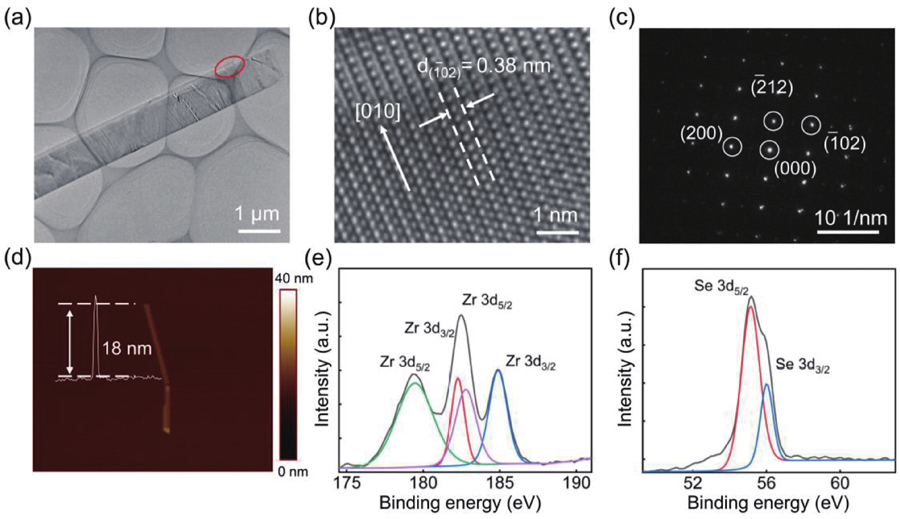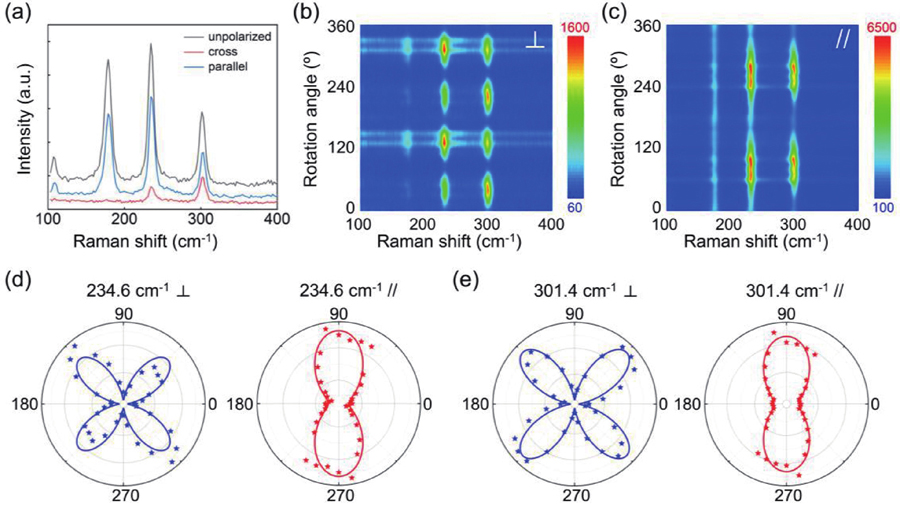Xingang Wang, Tao Xiong, Kaiyao Xin, Juehan Yang, Yueyang Liu, Zeping Zhao, Jianguo Liu, Zhongming Wei. Polarization sensitive photodetector based on quasi-1D ZrSe3[J]. Journal of Semiconductors, 2022, 43(10): 102001
Search by keywords or author
- Journal of Semiconductors
- Vol. 43, Issue 10, 102001 (2022)

Fig. 1. (Color online) Characterization of ZrSe3 crystal. (a) Low-magnification transmission electron microscopy (TEM) of the quasi-1D ZrSe3. (b) High-resolution transmission electron microscopy (HRTEM) image of the quasi-1D ZrSe3. (c) Selected area electron diffraction (SAED) pattern of the quasi-1D ZrSe. (d) The AFM image of ZrSe3 crystal. (e) High-resolution spectra of Zr 3d core level. (f) High-resolution spectra of Se 3d core level.

Fig. 2. (Color online) (a) Raman spectra under unpolarized and polarized laser (532 nm). (b) Counter maps of angle-resolved Raman spectra under cross configuration. (c) Counter maps of angle-resolved Raman spectra under parallel configuration. (d) Polar plots of angle-resolved and fitted peak intensities of 234.6 cm−1. (e) Polar plots of angle-resolved and fitted peak intensities of 301.4 cm−1.
Fig. 3. (Color online) (a) Atomic structure of ZrSe3 crystal. (b) Band structure of layered ZrSe3. (c) Calculated real parts and imaginary parts of the dielectric constant alonga-axis andb-axis. (d) TheRa andRb of optical transition |v> → |c> along the k-points path. (e, f) Partial charge density of ZrSe3 at the state of CBM and VBM respectively.
Fig. 4. (Color online) (a) Time-resolved photoresponse of the ZrSe3-based photodetector for a bias voltage of 5 V under 532 nm with different light power density. (b) Dependence of the photocurrent on the intensity of incident laser power. (c) The spectral responsivity and detectivity of ZrSe3-based photodetector. (d) Evolution of the photocurrent with a polarized angle under 532 nm.
Fig. 5. (Color online) (a−c) Time-resolved photoresponse of the ZrSe3-based photodetector for a bias voltage of 5 V under 450, 638 and 808 nm with different light power density respectively. (d–f) Evolution of the photocurrent with polarized angles under 450, 638 and 808 nm, respectively.
|
Table 1. Summary of the performance of a device based on quasi-1D ZrSe3.

Set citation alerts for the article
Please enter your email address



